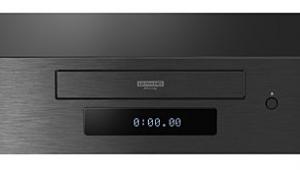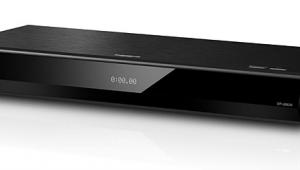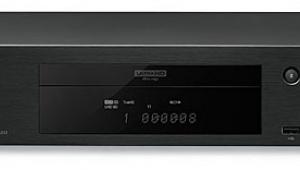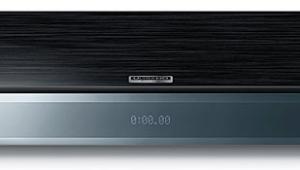Ayre Acoustics DX-5 Universal A/V Engine Page 2
 Getting USB Right, and the Computer Audio Paradigm
Getting USB Right, and the Computer Audio Paradigm
By their nature, computers aren’t high-quality digital audio sources. One critical aspect of the DX-5’s technology isn’t homegrown at Ayre; instead, Ayre licenses it from Wavelength Audio and its founder (and former computer engineer) Gordon Rankin. Rankin developed the code for the asynchronous USB data transmission mode used in the DX-5 (and in Ayre’s QB-9 standalone USB DAC). According to Hansen and Rankin, typical methods for USB transmission of audio data result in disastrously high jitter, or timing errors. The asynchronous mode doesn’t slave the connected DAC to any clock in the computer. Instead, the clock is in the DX-5, right at the DAC. The result is radically decreased jitter and improved sound.
You all know I’m big into front-projection-based home theater. But if I’ve kept a secret from you in my years at this magazine, it’s that I’m a fanatical two-channel audiophile as well, and I’ve gone big into Mac-based computer audio in the last couple of years. The Computer Audio Setup page on Ayre’s Website has clear and easy instructions (with screen captures) for optimizing Mac and PC computers for computer audio use with its USB DACs. I have a Mac mini in my main A/V system with a FireWire-connected 1-terabyte (soon to grow to 2-TB) hard drive to store my iTunes library’s music. iTunes is intuitive and easy to use, even though it’s not without its foibles. I also run iTunes with the Pure Music skin from Channel D ($129, channld.com) for improved sound quality.
The Apple/iTunes ecosystem for computer audio offers considerable power and flexibility. Throw in a $100 AirPort Express anywhere in the house, and you’ve got instant access to your iTunes library. Plus, the Mac mini doesn’t need a monitor; you can control it from any Mac on your home network over Wi-Fi using Apple’s built-in screen-sharing connectivity. Throw in an iPad with Apple’s free Remote app, and now you’ve got a chunky, gorgeous touchscreen remote to manage your iTunes library. Is this a mini Sooloos system for pennies on the dollar? Not quite. Sooloos manages the entire ripping, storage, and backup process, and its software is much more intelligent in terms of playback options and functionality. But the money I saved will buy me a really solid USB DAC, and my digital music library is still more enjoyable and easier to access than ever before, which means I listen more. And so does my wife. Want to get the Mrs. involved in your hi-fi fix? Hand her an iPad and let her pick her own tunes.
This was a really quick and dirty treatise on a broad topic, but I hope I’ve told you enough so you’ll know why I think computer audio is the bee’s knees—and why a truly high-end component that takes this ecosystem’s perormance to another level like the DX-5 does is a big deal.
USB Unbound: Audio Files for Audiophiles
I’ve been living with Ayre’s $2,500 QB-9 USB DAC for months. While the QB-9 employs Ayre’s Minimum Phase digital filtering, it has no disc drive. More significantly, it doesn’t share the DX-5’s advanced power-supply regulators for the analog circuitry. But I’ve found the QB-9 to be supremely unfussy and among the better digital components I’ve heard. This is why I was fairly taken aback when the DX-5 cleaned its clock (so to speak). As great sounding as the QB-9 is, the DX-5 is on another level entirely. On the DX-5, the QB-9’s superbly transparent sound gave way to additional layers of clarity and textural detail that shocked me. Instead of merely great sound, the musicians seemed to be in the room, imaged convincingly in strikingly realized three-dimensional space. Aimee Mann’s “This Is How It Goes” from Lost in Space (Mobile Fidelity, 16-bit/44-kHz) astounded, with vocal presence, a very liquid-sounding acoustic guitar, and incredible ambience. I’ve been using Lyle Lovett’s “North Dakota” from Joshua Judges Ruth (also 16-bit/44-kHz) for years, and I’ve honestly never heard its sonic images gel into such a convincing sonic portrait. Perhaps the most important attribute I could describe is the DX-5’s pure, liquid, analog-like digital sound. I listen to a lot of vinyl. This isn’t vinyl, but it’s as close to that analog ease as I’ve ever heard from digital. The DX-5 is not just an incredible-sounding digital component; this is legend territory.
Silver Audio Discs
The DX-5 is as superlative a disc player as I expected. I heard the same natural, richly detailed, and dynamic sound from all silver discs I played—especially my remaining SACDs and the few DVD-Video and DVD-Audio discs I have with high-resolution digital tracks. Let me be blunt: No other Blu-ray-based player I’ve heard, including Denon’s DVD-A1UDCI (HT, October 2009), approaches this level of sonic quality. This is a different animal altogether. Neil Young’s Live at Massey Hall presented some interesting comparisons. I own the limited CD edition, which ships with a DVD-Video disc with a 24-bit/176-kHz stereo track. This let me compare the 24-bit/176-kHz high-resolution DVD to the 16-bit/44-kHz CD. I also compared the 16-bit/44-kHz CD played from the DX-5’s disc tray to the same 16-bit/44-kHz track ripped to iTunes and played back over USB.
- Log in or register to post comments






























































